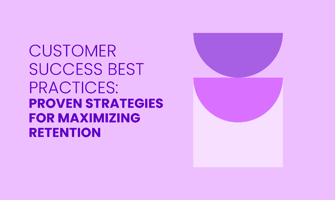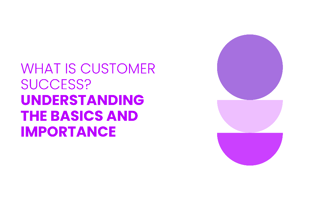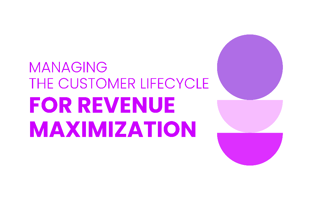Customer Success can affect a business's relationship with its customers. This guide shows how to...
Customer Retention Management: Strategies for Maintaining and Growing Your Client Base
Effective customer retention management involves strategies and practices aimed at keeping customers engaged and ensuring they return to your company. This approach is crucial for success in competitive markets, as it helps maintain and expand your customer base.
This blog post discusses the importance of customer retention and how it can positively impact your business's performance. We will explore various strategies that are effective in strengthening customer relationships.
By understanding these methods, you can enhance customer loyalty and drive growth, positioning yourself strongly in the competitive marketplace.
Importance of Customer Retention Management
Customer retention management helps you keep your existing customers, a crucial investment in the future of any company.
The numbers speak for themselves; there is a 60% to 70% chance of successfully selling to existing customers, who also spend 67% more than new customers. Because of this, focusing on retaining your current customers not only ensures ongoing sales but also enhances profitability.
Loyal customers also often become brand ambassadors, spreading positive word-of-mouth that naturally attracts new customers. This endorsement builds trust and strengthens your brand’s reputation.
Ignoring customer retention can lead to increased customer churn, where customers stop doing business with you. This can quietly undermine your company's foundation. This is why effective customer retention strategies are essential to maintain a robust customer base and ensure your company’s financial health and stability.
![]()
Strategies for Maintaining and Growing Your Client Base
1. Enhanced Personalization
Personalization is a strategy where businesses tailor their services and interactions to meet the unique preferences and needs of each customer. This method helps companies stand out in a busy market by making experiences that really connect with people.
Personalization involves customizing the content, offers, and communication based on a customer’s previous interactions, preferences, and purchase history. This targeted approach ensures that customers feel recognized and valued, which is fundamental to building strong relationships.
This approach is also good for the business because it makes customers more loyal and happy, which can lead to more sales and lower costs for marketing. By focusing on what each customer needs, companies can give better service and turn visits into sales more effectively.
Importance
Fulfilling Human Needs: Personalization taps into a fundamental human desire for recognition and understanding, making individuals feel valued on a personal level.
Beyond Basic Interactions: More than just using a customer’s name, it involves crafting content, recommendations, and solutions tailored to each customer's specific preferences.
Business Impact: Personalization can significantly enhance customer satisfaction and loyalty, which in turn can lead to improved business performance without specific statistics.
How to Implement Enhanced Personalization
Collect and Analyze Data: Start by collecting detailed data on customer interactions, preferences, and behaviors from multiple touchpoints such as online browsing history, purchase records, and customer service interactions. Use analytical tools to process the data, identifying patterns and preferences that reveal what customers truly want and how they interact with your offerings.
Segment Customers: Organize customers into distinct groups based on common characteristics or behaviors. Effective segmentation can be achieved using demographic data (age, location, gender), psychographic data (lifestyle, values), or behavioral data (purchasing habits, brand loyalty). This approach allows for more precise and effective personalization strategies.
Develop Personalized Content: Craft content and offers that are specifically designed for each customer segment. Utilize A/B testing, a technique where two versions of content are compared to determine which one performs better, to refine content effectiveness. Additionally, use tools such as content management systems (CMS) and digital marketing platforms that support dynamic content personalization, adjusting messages and offers in real-time based on user interactions and preferences.
Utilize Automation Tools: Implement automation software like marketing automation platforms, which help in delivering personalized content efficiently across various channels. Tools like these enable scalable personalization without compromising the quality of customer interactions.
180ops revenue intelligence suite integrates data-driven strategies into your customer service model, significantly enhancing your ability to engage with and support your customers proactively.
2. Omnichannel Support
Omnichannel support is a customer service approach where every interaction remains consistent across various communication platforms. Whether customers reach out via social media, email, live chat, or in person, they experience the same level of quality and attention. This strategy ensures that each customer feels recognized and valued, no matter how they choose to communicate.
This type of support integrates all customer interaction channels, allowing for a seamless transition from one mode of communication to another. For instance, a question asked through an email can be continued over a phone call without the customer needing to repeat information. This creates a smoother, more efficient customer experience that saves time and reduces frustration.
The main goal of omnichannel support is to enhance customer satisfaction by making interactions easy and consistent. This approach not only meets the immediate needs of customers but also builds long-term loyalty by showing that the company cares about their overall experience. By treating the customer's journey as a single continuous conversation, companies can foster a stronger connection and a deeper sense of trust.
Importance
Uniform Service Expectations: Omnichannel support is essential because customers today expect a consistent service experience, whether they are interacting online, in-store, or through customer support. They want to receive the same level of service and attention across all platforms.
Enhanced Customer Retention: A robust omnichannel strategy significantly enhances customer retention. Companies with integrated support systems tend to keep a higher percentage of their customers, contrasting sharply with those having disjointed service channels.
Customer Loyalty and Satisfaction: Seamless support across various channels not only meets the immediate needs of customers but also fosters loyalty and overall satisfaction, contributing to a stronger customer-company relationship.
How to Implement Omnichannel Support
Integrate Communication Channels: Create a seamless connection between all customer interaction channels. This integration ensures that customer data and interaction history are available regardless of which channel a customer chooses to use. It’s essential for delivering a consistent experience that recognizes the customer's past interactions across different platforms.
Maintain a Unified Customer Database: Develop a centralized database that captures all customer interactions. This database should be accessible to all service channels, allowing customer service representatives to view complete customer profiles and interaction histories. This comprehensive view is crucial for providing consistent and informed service.
Implement Comprehensive Training: Ensure that all customer service representatives are well-trained across various platforms. This step involves not just initial training, but ongoing education to keep up with new tools and strategies. Well-trained staff can provide more efficient and effective service, leading to better customer satisfaction.
Employ Data Analytics Tools: Utilize data analytics to gain deeper insights into customer behaviors and preferences across all channels. These insights can help tailor the customer experience more effectively and pinpoint areas for improvement in service delivery.
Monitor and Adjust: Continuously evaluate the effectiveness of your omnichannel strategy. Regular assessments, coupled with feedback from customers, should inform adjustments in your approach to ensure that it remains effective and responsive to customer needs.
3. Customer Education Programs
Customer education programs are designed to help customers understand and utilize a company’s products or services more effectively. These programs aim to increase customer engagement by providing essential knowledge that enhances the user experience.
By empowering customers with this knowledge, companies foster deeper appreciation and loyalty. Educated customers are more likely to use products to their full potential, leading to greater satisfaction and a stronger connection to the brand.
Also, customer education programs contribute to a positive experience, which is essential for building long-term customer relationships. These initiatives not only benefit customers but also support business growth by improving customer retention.
Importance
Satisfaction Benefits: Educating customers enhances their ability to use products effectively, increasing both customer satisfaction and loyalty.
Maximized Product Use: Well-informed customers are more likely to exploit the full capabilities of a product, leading to better user experiences and higher satisfaction.
Increased Retention: Customers who fully understand and effectively use a product are more likely to remain with a brand, boosting retention rates.
Stronger Relationships: Effective education helps build long-term relationships as customers feel supported and valued by the brand, fostering a positive environment and deepening customer engagement.
How to Implement Customer Education Programs
Identify Educational Needs: Begin by analyzing customer feedback and support queries to identify common issues or features that are underutilized. Understanding these areas will guide the focus of your educational content.
Develop Relevant Content: Craft educational materials such as tutorials, how-to guides, webinars, and FAQs. Make sure these resources are clear, concise, and structured to address the identified needs of your customer base. This content should be comprehensive enough to educate effectively yet simple enough for all customers to understand.
Utilize Varied Formats: Recognizing that different people learn in different ways, distribute your educational content in various formats. Include videos for visual learners, written guides for those who prefer text, infographics for quick insights, and interactive webinars for a more engaging learning experience.
Make Resources Accessible: Ensure that these educational materials are easy to find and use. Place them prominently on your website, integrate them into customer accounts, and share them through email newsletters. Accessibility is key to ensuring that customers will use and benefit from these resources.
Measure Impact and Gather Feedback: Implement analytics tools to track how customers use and interact with your educational content. Regularly solicit customer feedback to understand the effectiveness of your materials and identify areas for improvement. This ongoing evaluation helps refine your approach and ensures your educational offerings continue to meet customer needs effectively.
![]()
4. Loyalty and Incentive Programs
Loyalty programs and incentives are ways businesses say thank you to customers who keep coming back. These programs give customers special rewards, like discounts or early access to products, encouraging them to continue shopping with the brand.
Rewards make customers feel appreciated and give them extra reasons to stick with a company. For example, getting a price cut on a future purchase might encourage a customer to visit again.
Overall, these programs help build a strong bond between customers and businesses. Customers get benefits that make their purchases more valuable, and businesses keep their customers happy and coming back.
Importance
Enhanced Customer Retention: Loyalty programs strengthen the relationship between a brand and its customers by rewarding them for their continuous support. This makes customers feel valued and motivates them to remain connected with the brand.
Increased Customer Lifetime Value: These programs encourage customers to keep engaging with the brand, which boosts their overall value to the business over time. Regular participation in these programs leads to more frequent purchases and greater loyalty.
Transformation of Customer Behavior: Well-designed incentive schemes can turn occasional shoppers into regular customers and transform satisfied customers into brand advocates. These advocates actively promote the brand, extending its reach and influence through positive word-of-mouth.
How to Implement Loyalty and Incentive Programs
Identify Appealing Incentives: Start by figuring out which rewards will attract your customers the most. This might include discounts, exclusive content, or early access to new products. Understanding what motivates your customers will help you tailor the incentives to their preferences.
Simplify Program Enrollment: Make sure that it is easy for customers to join your loyalty program. A simple and straightforward sign-up process is key to getting more customers involved. Complicated processes can discourage them from participating.
Offer Clear, Achievable Rewards: Design your rewards so that they are easy to understand and attainable. Customers should know exactly what they need to do to earn these rewards and feel confident that they can achieve them without undue effort.
Leverage Customer Data for Personalization: Use the data you collect on customer preferences and buying behaviors to customize the rewards for each customer. Personalizing rewards in this way can make them more appealing and increase the value perceived by the customers.
Maintain Regular Communication: Keep in touch with your customers about their status in the loyalty program and inform them about upcoming benefits. Frequent communications can keep customers engaged and remind them of the ongoing value the loyalty program offers.
![]()
5. Proactive Customer Engagement
Proactive customer engagement means that you contact your customers first before they feel the need to reach out with issues or questions. This proactive approach involves anticipating potential problems or needs and addressing them early, which helps create a smoother, more satisfying customer experience. This strategy aims to build a stronger, more dynamic relationship with customers.
By addressing concerns and providing solutions before customers even have to ask, you can prevent many issues that might otherwise lead to dissatisfaction. This level of attentiveness shows customers that you are dedicated to their success and well-being, not just reacting to problems as they arise.
Engaging with customers in this proactive manner not only improves their overall experience but also builds trust. Customers come to see the company as a reliable partner that actively supports their needs. This can lead to higher customer loyalty and satisfaction, as customers appreciate the thoughtful, anticipatory service they receive.
Importance
Enhanced Customer Experience: Proactively engaging with customers can greatly improve their overall experience with your brand. Addressing needs before they become problems demonstrates care and commitment, which can lead to greater customer satisfaction.
Building Trust and Loyalty: By showing initiative in supporting their needs, you signal to customers that their success and satisfaction are important to your business. This proactive approach fosters trust and deepens customer loyalty.
Valuable Insights: Engaging with customers proactively also provides opportunities to gather feedback and understand customer sentiments. These insights are crucial for refining your products and services to better meet their needs.
How to Implement Proactive Customer Engagement
Monitor Customer Behavior: Start by observing how customers use your products or services. Look for any signs that might indicate they need help, such as frequently visiting the same help page or pausing for a long time on a specific step. Identifying these patterns allows you to understand their challenges and address them proactively.
Develop Outreach Campaigns: Create campaigns that proactively communicate with customers about new updates, features, or helpful tips tailored to their usage and needs. This proactive communication helps keep customers well-informed and demonstrates your commitment to enhancing their experience with your brand.
Utilize Automation Tools: Leverage technology by using customer success platforms to automate your proactive engagement efforts. These tools can help you manage and time your communications effectively, ensuring that you reach out to customers at the right moment with the right message.
Offer Timely Help: Act swiftly to offer assistance when you notice a customer might be struggling. Immediate support can be provided through various channels such as live chat, email, or phone. Quick and effective help not only resolves issues but also boosts customer satisfaction by showing that you are attentive and responsive.
Feedback Loop: Make it a routine to ask for customer feedback through surveys or direct interactions. This input is invaluable for refining your engagement strategies and adapting to customers’ evolving expectations. Continuous improvement based on feedback ensures that your proactive engagement remains effective and relevant.
![]()
Conclusion
Retaining and growing your client base is essential for sustained business success. Implementing comprehensive customer retention strategies is vital for maintaining a competitive edge and fostering long-term loyalty.
Key strategies include enhanced personalization, omnichannel support, educational programs, loyalty incentives, and proactive customer engagement.
Investing in these areas helps reduce turnover and enhances every stage of the customer journey. Customer retention contributes to stable business growth and supports an ever-expanding community of loyal customers. In the end, each customer's success directly supports the flourishing of your business.
FAQs
What is customer churn and how does it impact customer retention rate?
Customer churn, also known as Kundenabwanderungsquote, refers to the percentage of customers who stop using your business's services or products over a specific period. A high churn rate can significantly impact your customer retention rate, as it indicates more customers are leaving, which can negatively affect revenue. Strategies to reduce churn are essential for maintaining a healthy retention rate and ensuring ongoing business growth.
How can interactive walkthroughs and new features improve user satisfaction and customer retention?
Interactive walkthroughs and the introduction of new features can greatly enhance the account experience and user satisfaction by making your product more engaging and easier to use. These tools help familiarize customers with your product, which can increase product stickiness and customer loyalty, thereby improving the lifetime value of each customer and boosting overall customer retention.
Can you provide examples of metrics to track for improving customer retention rate?
To improve your customer retention rate, consider tracking metrics like expansion MRR (Monthly Recurring Revenue), average customer lifespan, and surveying customer satisfaction. These data points provide insights into how long customers stay with your brand, how much they are spending over time, and their overall satisfaction levels. Analyzing this data helps tailor your customer retention program to better meet the needs of different customer segments.
What role does lifetime value play in customer retention strategies?
Lifetime value is a critical metric in customer retention strategies as it represents the total revenue a business can expect from a single customer account throughout their relationship. By understanding and increasing the lifetime value, businesses can justify investing more in retention efforts like enhanced onboarding, customer thermometer tools for immediate feedback, and creating promoters who will recommend your brand through referrals.
How can companies use customer acquisition data to improve their customer retention program?
Using customer acquisition data can enhance your customer retention program by identifying which acquisition channels bring in the most loyal customers. This information allows businesses to optimize their marketing efforts, focus on high-value channels, and tailor the onboarding process to increase product stickiness and customer value.




